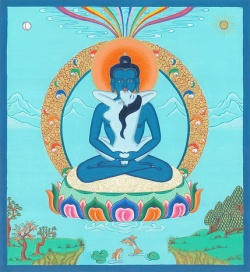Most excellent first Buddha
(T.) mc'og-gi dan-pohi sans-rgyas (lit. most excellent first Buddha); or dus-kyi hkor-hhi mts'an (lit. the saint of (the religion of the) wheel of Time).
(M.) anghan burhan (the beginning deity).
In the Guna Karanda Vyuha it is written:
'When nothing else was, Sambhu was: that is the Self-Existent (svayambhu): and as he was before all, he is also called Adi-Buddha.' 1
The first system of Adi-Buddha was set up in Nepal 2 by a theistic school called Aisvarika, but was never generally adopted in Nepal or Tibet, and had practically no followers in China and Japan. 3
The Nepalese school supposed an Adi-Buddha infinite, omniscient, self-existing, without beginning and without end, the source and originator of all things, who by virtue of five sorts of wisdom (jnana) and by the exercise of five meditations (dhyana) evolved five Dhyani-Buddhas or Celestial Jinas called Anupapadaka, or 'without parents'.
When all was perfect void (maha-Sunyata) 4 the mystic syllable aum 5 became manifest, from which at his own will the Adi-Buddha was produced. At the creation of the world he revealed himself in the form of a flame which issued from a lotus flower, and in Nepal the Adi-Buddha is always represented by this symbol. 6
All things, according to Hodgson, were thought to be types of the Adi-Buddha, and yet he had no type. In other words, he was believed to be in the form of all things and yet to be formless, to be the
'one eternally existing essence from which all things are mere emanations' (Monier Williams).
According to the system, Adi-Buddha was supposed to dwell in the Agnishtha Bhuvana (the highest of the thirteen 7 Bhuvana, or celestial mansions), quiescent and removed from all direct communication with the world which he had caused to be created by the Dhyani-Bodhisattva, through the medium of the Dhyani-Buddha.
[Page 3] It was believed that neither the Adi-Buddha nor the Dhyani-Buddha ever descended to earth, but left the creation and direction of the world's affairs to the active author of creation, the Dhyani-Bodhisattva, and that as they were absorbed in perpetual contemplation, prayers were not to be addressed to them.
Other sects in Nepal, besides the Aisvarika, set up an Adi-Buddha, the most important being the Svabhavika, which afterwards became the most popular Buddhist sect in China.
Svayambhu, or Adi-Buddha, was called Isvara by the Aisvarika, and Svabhava by the Svabhavika; but he was also given such special names as Vairocana, Vajrapani, Vajradhara, and Vajrasattva. In the Namasangiti (compiled before the tenth century a.d.) Manjusri, god of Transcendent Wisdom, is referred to as Adi-Buddha.
The Adi-Buddha is always represented as a 'crowned' Buddha, that is to say, that although he is a Buddha, he wears the five-leaved crown as well as the other traditional ornaments of a Dhyani-Bodhisattva, and is dressed in princely garments. His consort is Adi-Dharma (Adi-Prajna).
In Japan, although the term 'Adi-Buddha' is not known, the Dhyani-Buddhas, Amitabha and Vairocana, are both looked upon as Supreme. They are not believed, however, to have evolved the five Dhyani-Buddhas. The Amida sects claim that Vairocana and the other three Dhyani-Buddhas are manifestations of Amitabha, while the Shin-gon sect claims that Amida and the other three Dhyani-Buddhas are manifestations of Vairocana. They are never worshipped in company with their sakti 8 while in Nepal and Tibet the Adi-Buddha is frequently represented with his female energy, in which case he is called Yogambara, 9 and the sakti, Jnanesvari.
